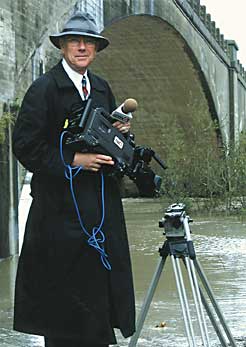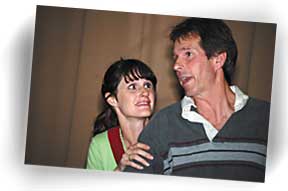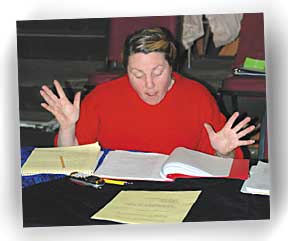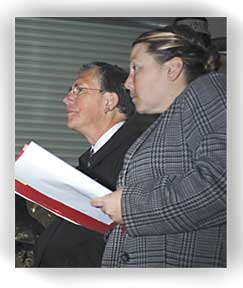|
COVER STORY | IN
THE NEWS | ARTBEAT
| FILM
FESTIVAL March 30, 2006
by WILLIAM S. KOWINSKI
The man in the video is the man showing it to me on an ancient monitor perched on a riser at the Star Garden Theatre Art Center: Dave Silverbrand, one of the most familiar faces in Humboldt County television. The clips, which Silverbrand edited together to create what amounts to a character in his new play, The Tree, are from his own career. There are six or seven of these taped segments, which the audience will see while the live cast accomplishes its scene changes. This is one of the joys of this play for him, the live Silverbrand claims. "I get a chance to laugh at myself," he says, "which I enjoy doing very much." Left: Dave Silverbrand at Fernbridge. Dave Silverbrand (the surname is an Americanization of a common Swedish name) was born in King City, south of Salinas, and grew up in various small towns down in Steinbeck country. In high school his English teacher suggested he attend a town council meeting and write something about it for the local radio station. He did, and found he liked it a great deal. Until then he hadn't even imagined a career in broadcasting, but after earning a B.A. in journalism at San Jose State University, he wound up in Portland, Maine, where he worked as a television reporter and substitute anchor for the next 20 years. Silverbrand returned to California in 1992. After a couple of years as a reporter for KIEM-TV, he went back to school and earned his Master's in English at HSU, where he also taught and was heard on KHSU radio. By 1997 he was back in TV broadcasting, as news director at KVIQ-TV, Channel 6. He was Channel 6's news director, anchor and star reporter. He and his news staff, the largest TV news operation in Humboldt County at the time, generated 22 hours of local news a week -- news at 6 a.m., news at 5 p.m., news at 6 and 6:30 and 11 p.m. The Ackerley Group, owner of Channel 6, poured a million dollars into staff and equipment. Even when they lured away the anchor of rival KAEF (Channel 23), Silverbrand remained the genial face of Channel 6 news. Then, suddenly, it was over. About six years ago, Ackerley sold out to the broadcasting behemoth Clear Channel Communications (which reportedly was most interested in Ackerley's billboard business). As a result of the sale, the Channel 6 local newscasts were closed down completely. Silverbrand, who continued to provide one local news story a day for Clear Channel's station in Santa Rosa, was one of the few at Channel 6 to survive this sale. But in 2005, KVIQ was sold again, this time to Raul Broadcasting, and for a short time Silverbrand was out of a job entirely. Then Raul Broadcasting hired him back as the station's general manager. Except for an engineer, he is the station's only employee. He does its local segments, such as his "Project Lean" (healthful food) and "Project Green" (Arcata Recycling) series. He has also revived "Dave Is," which he began doing in previous Channel 6 incarnations -- "a kind of comical thing where I try different peoples' jobs," as he described it.
Left: Dave's radio days. Photo courtesy of Dave Silverbrand. Silverbrand showed me another of The Tree's taped segments when I visited his Channel 6 office, a cramped, narrow space in the Eureka building where Eureka Television Group runs its four stations in addition to KVIQ. The premise of the clip is that the reporter, now bored and angry because the "big story" he's covering is moving too slowly, is being interviewed by a grade-school girl for her school newspaper. She asks him general questions like "What is your job?" and he gives increasingly resentful answers, complaining that he is called in to anchor when "the little punk calls in sick," and he loses choice assignments to reporters who bat their eyelashes "and shake their booties." As he continues to rant even after the girl says she has to go, the segment is genuinely funny. But it is pretty biting, if not bitter, so I asked Silverbrand if that's how he feels about his own career. "Sure, this is how I feel, that's the point," he said. "In 35 years, I've had cases where I had to come in and fill in for the little punk who calls in sick, and I've been upstaged by the anchor queens, because they're the anchor queens. There's a lot about TV that's superficial, and I've watched people just slide into these plum assignments because that's the way TV is. It ticks me off sometimes. "The rest of the time I'm having such a good time it doesn't matter. That's why I'm enjoying myself with this play. Because it gives me a chance to say a few things, without sounding like some grousing, grumbling old man. I can be a humorist and say the same thing. It's great." Because, as it turns out, Silverbrand and I are almost exactly the same age (born six weeks apart in the summer of 1946) and had our first journalism jobs at the same time a few hundred miles apart (I was a writer and editor for the Boston Phoenix while he was getting started in Maine), I happen to know something more about the peculiar point in media history when Silverbrand was beginning his television career. There were few women on the air in television news until 1971 or so. Boston's largest TV station, WBZ, had one female reporter, a middle-aged woman respected for her reporting skills. But a few years later there was a huge influx of primarily young and attractive women hired to be on the air, at first as "soft" news reporters, then general assignment reporters, then talk show hosts and co-anchors on new early news shows, then, by mid-decade, as the anchor chair on the more established news programs. Several proved to be very good at television news. The alarmingly beautiful Natalie Jacobson, who became the first woman to anchor the evening news in Boston, is still a popular (and now award-winning) newscaster at the same station, WCVB. Pat Mitchell, who I met when she was the WBZ film and theatre reviewer, is now the head of PBS. But there were others. On a story, I had to attend a public hearing in Boston concerning telephone company regulation. I arrived an hour or so into it and saw a group of reporters standing in the press section, but I didn't know any of them. However, there was a tall, extremely striking woman I'd seen on TV, and of course she's the one I chose to approach, to catch up on what had gone on so far. She smiled her blinding smile at me and giggled. In her long, perfectly manicured fingers she held a reporter's notebook, completely blank. Of course, there were male anchors more famous for their handsome smiles than their penetrating intelligence (the urban legend about Boston's biggest anchor star had him solemnly warning that a missing child should be approached carefully, because he was "acoustic"), and airhead anchors of both genders have since become a living cliché. But at precisely the moment Dave Silverbrand was starting out, this rapid influx of young women into local broadcasting was skewing the system to the detriment of other reporters, before some balance was achieved. Though it wasn't easy for the young women either, it could be frustrating for young men. But Silverbrand coped with all the change for 20 years in Maine, and could have stayed longer. "People I worked with years ago are still there," he said. Or he could have tried to advance to more prestigious and better-paying media markets in bigger cities. "I didn't have the fever for big-city TV," he said. "I'm kind of a small-town guy." Since coming to the North Coast to be closer to his California family, Silverbrand has felt the effects of media conglomerates as well as all the other outrages. So besides satirizing his fate in a play, how does he deal with it? "If I had just acquiesced to the way things were, I would be incredibly angry and disillusioned," he said. "But I learned early on that if something is really important to you, you go ahead and do it." Case in point: In 1982, a young Maine schoolgirl named Samantha Smith wrote to Yuri Andropov, then the Soviet Premier, telling him of her fears about nuclear war. He invited her to Moscow, and her trip became a media sensation.
So Silverbrand organized high-school student trips to Russia and went with them for four consecutive years. "That was even more fulfilling to me than covering Samantha Smith. And that's the way I've been doing things ever since." Left: Reporting from the U.S.S.R. Photo courtesy of Dave Silverbrand. Even when he was the one-person news staff for Channel 6 during the Clear Channel period, and he got a hankering to go to Cuba: "I knew nobody I worked for would send me, but I really wanted to go. I knew I would have to pay my own way, so I did." He also took a camera. And since he was responsible for providing Clear Channel's Santa Rosa station with one story a day from Humboldt, he fed them his series on Cuba. "What were they going to do? They had to put something in that slot. And I had just a wonderful time, talking to Cuban people." These days Silverbrand also teaches English and journalism classes at College of the Redwoods, and passes on this lesson: "I tell my students, 'You can do things that are important to you, you can find a way. You don't have to be told to do it, just go out and do it, and make a difference, and feel good about yourself. If you let others write all the rules for you, you're not going to get anything done.' In its own passive-aggressive way, what I did was revolutionary. So I tell them, 'Just find a way to work the system, you can have an awful lot of fun.'" In the end, that seems to be Silverbrand's dominant feeling about his career. Veteran CBS journalist Mike Wallace had announced his retirement a few days before our conversation. Silverbrand watched an interview with him. "I thought, dammit, I've had as much fun at my job as he's had at his. I didn't make nearly as much money, and I didn't work on a national TV network, but I've had a ball. And I'm not done." The story in The Tree pits two families against each other: One father is an ex-hippie environmentalist who is now produce manager at the Co-op, the other an ex-logger now working in a lumber yard. They are battling over a single tree in the heart of town -- should it be cut down to make bleachers for the high school football team, or left to live out its natural life? An aggressive police chief and a cautious mayor are between them. This is not Silverbrand's first play (a documentary
drama called The Lobster War, based on his Maine reporting,
was produced at the Eagle House in 1999), but it is his first
comedy and work of the i Right: Cast members of 'The Tree.' Silverbrand and director Denise Ryles agree that the theme of the play is change, and how people cope with it, and try to locate a new identity in flux. The action -- which includes protests, police plans for subduing protestors, city council meetings, etc. -- seem to come from familiar local events, many of which he covered as a reporter. They are situations rife with conflict, but that's always fascinated Silverbrand, from the first town council meeting he witnessed as a teenager. "These personalities clashing with each other, these people bickering and picking at each other -- it just seemed like so much fun to me." This attitude toward local conflicts, however,
may be contrary to North Coast tradition. "Everybody here
has an opinion about conservation and environment, and it's a
pretty deeply held philosophy. You don't find too many ambivalent
people around here. But there are some parts of the country where
Left: Director Denise Ryles. Silverbrand found his ideal production partners in the Vagabond Players, a troupe specializing in children's theatre whose roots go all the way back to the 1970s and the Pacific Arts Center Theatre, a groundbreaking North Coast company. Vagabond recently opened a new space -- dubbed the "Star Garden Theatre Art Center" -- in the old Arcata Creamery building, the very place that PACT got its start. The company's first foray in its new space was
an ambitious production last fall of Maurice Sendak's Where
the Wild Things Are, directed by Mark Dupre. Last
September, Silverbrand showed up to do a story on Wild Things.
He mentioned his play, which he'd continued to work on over the
years. "They said, well, it would be our first adult production,"
Silverbrand recalls, "but let's take a look at it, and they
did, and pretty much on the spot said they wanted to do it." Right: Dave and director Denise Ryles. Coming in from the March mist and cold, the space inside the Creamery building feels immediately welcoming. The very high ceilings add to a sense of spaciousness and possibility, and there's a warmth in the combination of modest fixtures and the theatre's elegant wood floor. The homey reception area has a refreshment bar, topped with the large masks from Where the Wild Things Are, and a revolutionary new concept in local community theatre -- two (count 'em, two!) restrooms, one next to the other. For The Tree, 10 actors, some of them in their first production, gather here for rehearsals along with Ryles, a veteran Humboldt County actor who directed her first show a few years ago. "Dave Silverbrand and I go way back," she told me. "I was in an English class he taught at HSU, and later he would come into The Costume Box, the shop my mother and I have. He was doing his 'Dave is...' thing on Channel 6, and we'd dress him up for the different things he wanted to do." So Ryles agreed to direct. Her mother, Rosemary
Smith, designed the show's costumes. By all accounts, Silverbrand
worked closely with the production, from involvement in casting
to attending rehearsals and making revisions according to what
he saw and experienced. "I believe in having the writer
here," Ryles said. "He can hear it and decide for himself
if it sounds good or not. He can help the actors, and maybe the
actors can add something, so he's here to decide to keep it or
not. I think he's very happy. He told me this is just how he
imagined it to be." Silverbrand said he hasn't seen the Dell'Arte play about a tree-sitter, Shadow of Giants, now on national tour, so he can't make any comparisons. "I'm not saying this is one of the great plays of all time -- it's not," he added. "But it is a local satire, an opportunity for all of us to laugh at ourselves. That's pretty much the value of it." Left: Candice Campbell gets airbrushed by artist Michael Bean in preparation for her role in 'The Tree.' Photo by Chris Wisner. For all his fascination with disagreements, Silverbrand seemed proud to point out that he got along well with both police and tree-sitters during the protests in Freshwater a few years ago. Though Silverbrand refused several invitations to climb a tree, he and Jeny Card -- also known as Remedy -- were cell phone friends. He remembers answering his cell in a San Francisco hotel where he was on a Christmas shopping trip with his wife, and it was Remedy calling from her tree home, just saying hello. Everybody likes Dave. But will they feel the same way after this play? "I think he wrote a real heartfelt piece," Ryles said, and added with a grin, "He makes fun of everybody equally."
Performances of The Tree are Thursdays, Fridays and Saturdays at 8 p.m. and Sundays at 2 p.m., March 30 to April 15. There is also a matinee on Saturday, April 15. Tickets are $10, $8 students/seniors. 2-for-1 tickets on Preview Night, March 30. The Star Garden Theatre Art Center is in the Old Creamery Building, at 1251 9th Street in Arcata. The theatre seats about 100 for this production. Call 442-1533 for reservations and information. This is a show for adults. Proceeds benefit Food for People. COVER STORY | IN
THE NEWS | ARTBEAT
| FILM
FESTIVAL Comments? Write a letter! © Copyright 2006, North Coast Journal, Inc. |


 The
tall reporter in the trenchcoat and floppy hat talks earnestly
to the camera about his thwarted ideals. Images of his heroes,
like Edward R. Murrow and Walter Cronkite, flash across the screen.
His own career hasn't amounted to much. We see him doing forlorn
stand-ups and getting tossed out of a rock concert. He needs
one big story to justify his career.
The
tall reporter in the trenchcoat and floppy hat talks earnestly
to the camera about his thwarted ideals. Images of his heroes,
like Edward R. Murrow and Walter Cronkite, flash across the screen.
His own career hasn't amounted to much. We see him doing forlorn
stand-ups and getting tossed out of a rock concert. He needs
one big story to justify his career. Silverbrand
has the image and presence of an easy-going guy. But he doesn't
like inactivity. So in his underemployed period about four years
ago, he sat down and wrote a play: A satirical look at a North
Coast conflict, centered on the survival of a tree. One of the
characters is a veteran TV news reporter, worried and angry that
his 35 years of reporting hasn't amounted to much, who is trying
to redeem his own self-image with one last great story.
Silverbrand
has the image and presence of an easy-going guy. But he doesn't
like inactivity. So in his underemployed period about four years
ago, he sat down and wrote a play: A satirical look at a North
Coast conflict, centered on the survival of a tree. One of the
characters is a veteran TV news reporter, worried and angry that
his 35 years of reporting hasn't amounted to much, who is trying
to redeem his own self-image with one last great story. "It
was a big global story, one of those stories that I wanted to
do so badly, I could ace that story -- but somebody else, for
those superficial reasons, got to go and do it," Silverbrand
recalled. "I felt so angry and left-behind about that. But
I said, Dave, you can come up with your own way to do something
like that. You don't have to wait for somebody else to write
your ticket, you can do it yourself."
"It
was a big global story, one of those stories that I wanted to
do so badly, I could ace that story -- but somebody else, for
those superficial reasons, got to go and do it," Silverbrand
recalled. "I felt so angry and left-behind about that. But
I said, Dave, you can come up with your own way to do something
like that. You don't have to wait for somebody else to write
your ticket, you can do it yourself." magination.
It seems his English masters' degree paid off, for it also includes
star-crossed lovers in a Romeo and Juliet subplot, as well as
a mysterious figure, a elderly woman who becomes a key player
in the unfolding story.
magination.
It seems his English masters' degree paid off, for it also includes
star-crossed lovers in a Romeo and Juliet subplot, as well as
a mysterious figure, a elderly woman who becomes a key player
in the unfolding story. people
laugh at themselves on a regular basis," Silverbrand mused.
"Where I lived in Maine, it's part of the culture to laugh
at yourself. Different parts of the country are the same way.
We take ourselves very seriously up here -- too seriously sometimes,
I think."
people
laugh at themselves on a regular basis," Silverbrand mused.
"Where I lived in Maine, it's part of the culture to laugh
at yourself. Different parts of the country are the same way.
We take ourselves very seriously up here -- too seriously sometimes,
I think."

